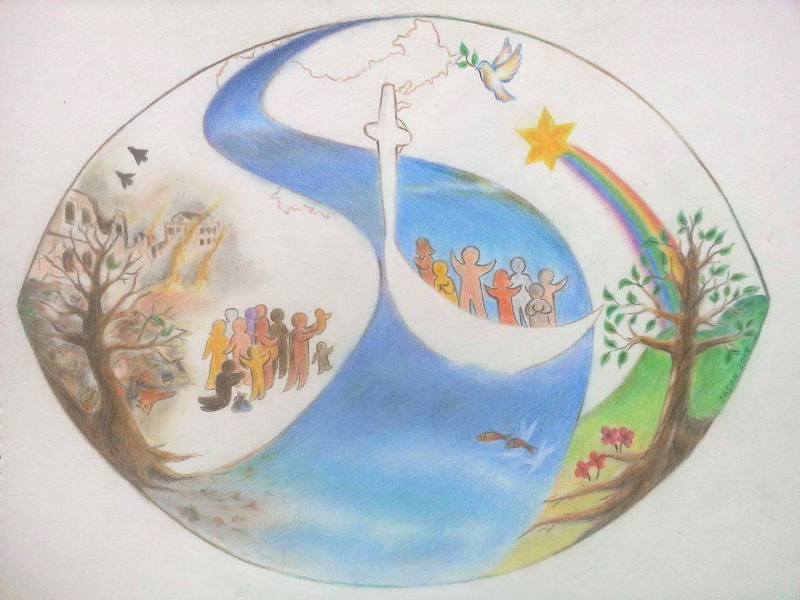100 Years of Columban Mission Through Art
Through the Eyes of a Filipino Columban
By Fr. Jason Antiquera
The author is a Columban priest from Binalbagan, Negros Occidental. He has spent some time in Korea and Peru as a seminarian. He was ordained on January 7, 2015 and on the same year left for Korea, and has worked there since then.

The Missionary Society of St. Columban was founded by two diocesan Irish priests, Fr. Edward Galvin and Fr. John Blowick, on June 29, 1918. The celebration of the 100th anniversary of the Society’s foundation began on November 23, 2017 and will end on November 23, 2018. Columbans all over the world have been exchanging ideas to create programs and activities for a meaningful centennial celebration. On a personal level, I was glad to be asked to create an art that could capture this hundred-year history of Columban mission. What a task! But it has to be done.
The art impression is based on the centennial prayer and the journey of Columban Missionaries way back from the time of our founders up to the present. While reflecting, I let its message sink into my consciousness, allowing images to form and arrange themselves naturally in my mind. After such preparation, I sat down and painted these images. And what came out was a symbolic art filled with familiar and not-so familiar meanings. This is the artwork and its meaning, a product of prayerful reflection.

Mandorla. As one can immediately notice, the artwork takes in the form of an almond shape called Mandorla. The first inspiration of this shape is the official logo of the Society, taking only the middle portion where two worlds meet.
Boat. This widely-used image has been a traditional symbol often used by the Columbans, getting its inspiration from St. Columban sailing on a boat together with other monks. By using this image, I want to affirm the continuity of this tradition way back from the time of our founders. However, there are new and current developments in and about mission: the images of people found in the boat are of different colors and includes female images; this recognizes the present reality of multi-culturality and multi-ethnicity in the membership of the society, and the participation of lay and women in the missionary work of the church.
River. It represents journey and movement in time and space through which mission flows. The various spectrums of colours of the river is intentional; time and space are always not the same; there are changes and mission goes with them. Likewise, water is very important in the spirituality of mission; mission just like water is fluid and not fixed; water takes the form of anything concrete where it passes and, I believe, that's what we Columbans have embraced – fluidity. Historically, we constantly change our approach to mission depending on the situation of the world and the Church.
An outline of China's map. I put an image of China's map because the missionary journey of the Society started in China. I placed it in the far end of the river's horizon to signify its existence since the beginning of Society's mission. The image only takes the form of an outline recognizing its subdued but significant presence in the missionary life of the Society.
The cross, the crescent moon and the star. If you ask where the crescent moon is, the boat takes that form, while the star takes the specific form of David's star. They all symbolize the present call of inter-religious dialogue in mission where we Columbans are actively involved.
The group of people standing beside the river, the dying tree, garbage and war on the left side of the mandorla. The people represent the poor and the migrants, a crucial global issue and an important concern of the Church’s mission at the moment. Poverty and migration are direct results of war, and indirectly by the destruction of environment and climate change. These are all issues of justice, peace and integrity of creation, which many of the Columbans everywhere in the world are actively participating.
The green pasture, a tree filled with leaves and flowers on the right side of the mandorla. They all represent life, beauty and the kind of world where we hope to live; it's like the reign of God on earth – already present but not fully. The rainbow is a significant symbol in the book of Genesis representing God's first sign of covenant to the entire creation and God's faithfulness to His people. In our case, this covenant is made present and visible through mission. I also put the traditional symbol of peace and hope – the dove with an olive branch seen over the boat to represent that missionaries strive to work for peace and give hope to the world. The dove is also a shadow representation of St. Columban (whose name means “White Dove”).
The cross at the center. God through Jesus Christ is the heart of mission work. God is present in the journey of Columban missionaries wherever they go to proclaim the Good News to the world and become witnesses of the joy of the Gospel.
Over-all, I did not fill the entire space with colors and images but rather left some empty white untouched spaces so that images and color stand out and give room for breathing.
It was a challenge to express and put together through art the hundred years of mission history of the Society. However, it was also my joy to be able to express the Columban history, spirituality and journey through the language of symbols, images and colors when often they are only expressed in words.

Mural by Fr. Jason Antiquera, Korea, 2017
The mural is located at the entrance of the hospice inside St. Isidore Farm, which was established by Columban Fr. Patrick J. McGlinchey in Jeju Island.
